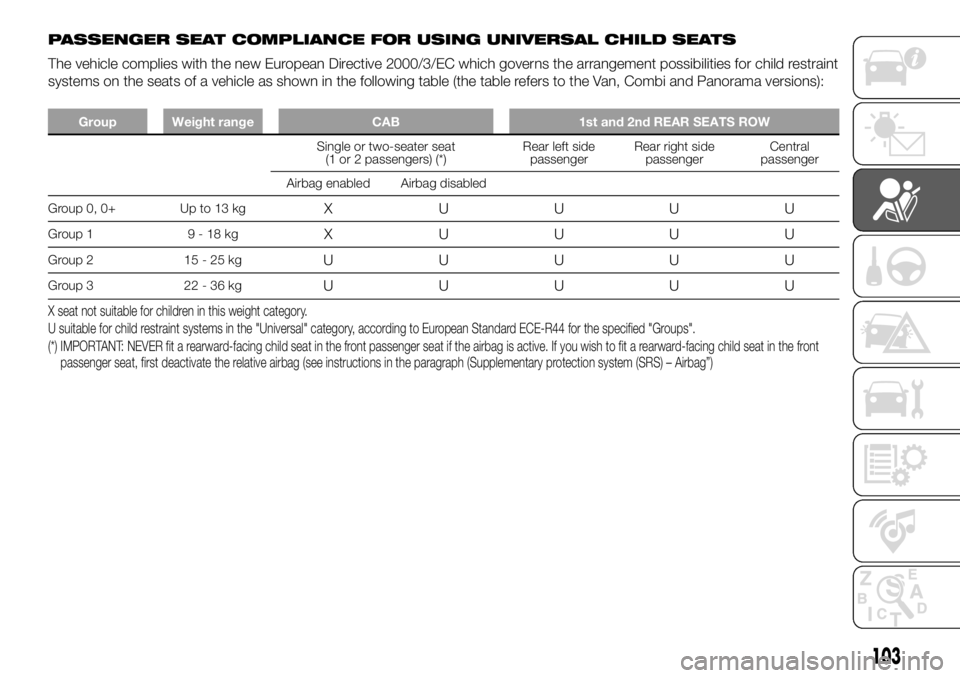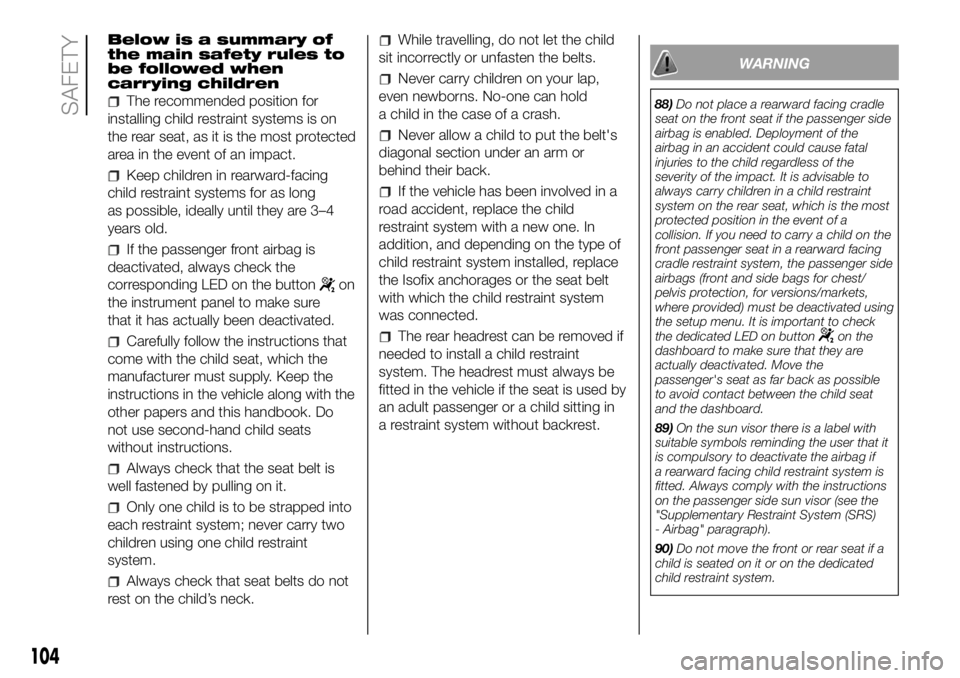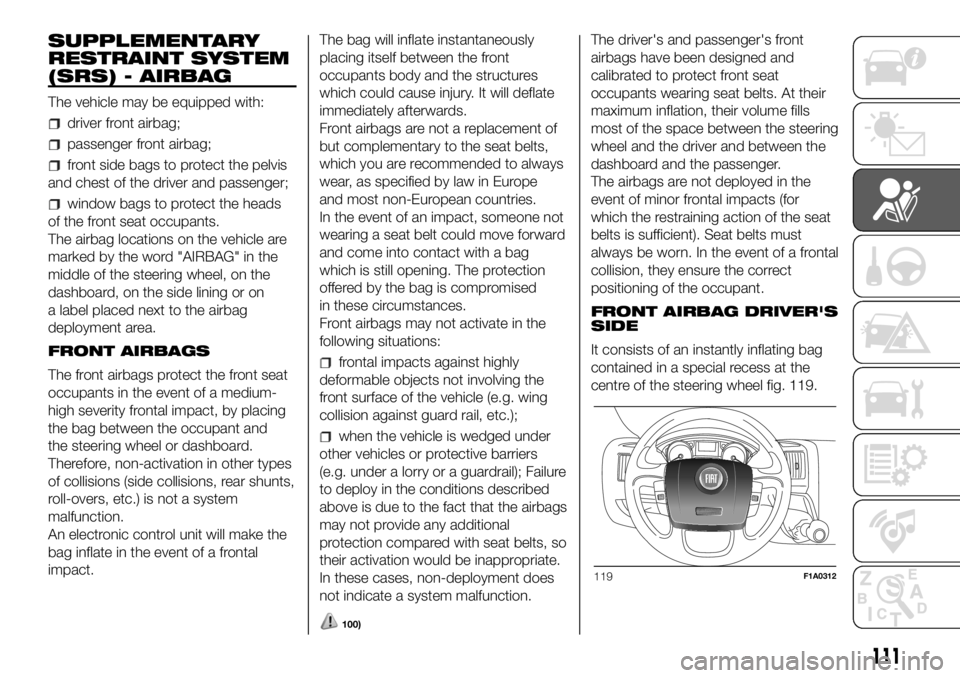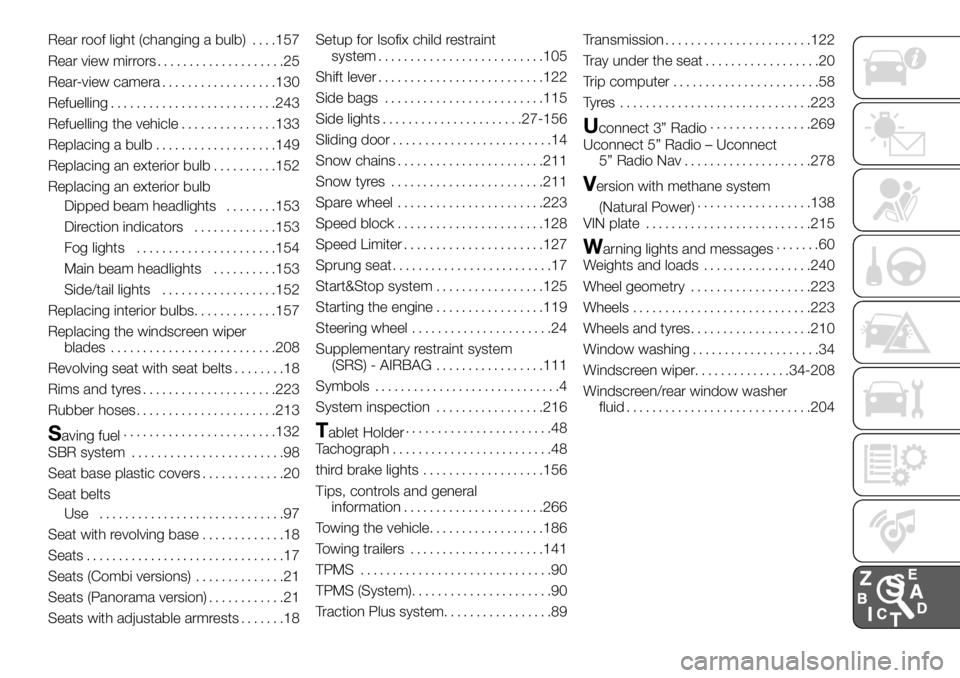Srs FIAT DUCATO 2018 Owner handbook (in English)
[x] Cancel search | Manufacturer: FIAT, Model Year: 2018, Model line: DUCATO, Model: FIAT DUCATO 2018Pages: 304, PDF Size: 14.93 MB
Page 86 of 304

SAFETY
The chapter that you are about to read
is very important: it describes the
safety systems with which the car is
equipped and provides instructions on
how to use them correctly.ABS SYSTEM ................................. 85
ESC (ELECTRONIC STABILITY
CONTROL) SYSTEM ....................... 86
TRACTION PLUS SYSTEM ............. 89
TPMS (TYRE PRESSURE
MONITORING SYSTEM) ................. 90
DRIVING ADVISOR ......................... 93
SEAT BELTS ................................... 97
SBR SYSTEM ................................. 98
PRE-TENSIONERS ......................... 98
CARRYING CHILDREN SAFELY ......101
SETUP FOR “UNIVERSAL ISOFIX”
CHILD RESTRAINT SYSTEM ..........105
SUPPLEMENTARY RESTRAINT
SYSTEM (SRS) - AIRBAG................111
84
SAFETY
Page 105 of 304

PASSENGER SEAT COMPLIANCE FOR USING UNIVERSAL CHILD SEATS
The vehicle complies with the new European Directive 2000/3/EC which governs the arrangement possibilities for child restraint
systems on the seats of a vehicle as shown in the following table (the table refers to the Van, Combi and Panorama versions):
Group Weight range CAB 1st and 2nd REAR SEATS ROW
Single or two-seater seat
(1 or 2 passengers) (*)Rear left side
passengerRear right side
passengerCentral
passenger
Airbag enabled Airbag disabled
Group 0, 0+ Up to 13 kg
X UUUU
Group 1 9 - 18 kgX UUUU
Group 2 15 - 25 kgUUUUU
Group 3 22 - 36 kgUUUUU
X seat not suitable for children in this weight category.
U suitable for child restraint systems in the "Universal" category, according to European Standard ECE-R44 for the specified "Groups".
(*) IMPORTANT: NEVER fit a rearward-facing child seat in the front passenger seat if the airbag is active. If you wish to fit a rearward-facing child seat in the front
passenger seat, first deactivate the relative airbag (see instructions in the paragraph (Supplementary protection system (SRS) – Airbag”)
103
Page 106 of 304

Below is a summary of
the main safety rules to
be followed when
carrying children
The recommended position for
installing child restraint systems is on
the rear seat, as it is the most protected
area in the event of an impact.
Keep children in rearward-facing
child restraint systems for as long
as possible, ideally until they are 3–4
years old.
If the passenger front airbag is
deactivated, always check the
corresponding LED on the button
on
the instrument panel to make sure
that it has actually been deactivated.
Carefully follow the instructions that
come with the child seat, which the
manufacturer must supply. Keep the
instructions in the vehicle along with the
other papers and this handbook. Do
not use second-hand child seats
without instructions.
Always check that the seat belt is
well fastened by pulling on it.
Only one child is to be strapped into
each restraint system; never carry two
children using one child restraint
system.
Always check that seat belts do not
rest on the child’s neck.
While travelling, do not let the child
sit incorrectly or unfasten the belts.
Never carry children on your lap,
even newborns. No-one can hold
a child in the case of a crash.
Never allow a child to put the belt's
diagonal section under an arm or
behind their back.
If the vehicle has been involved in a
road accident, replace the child
restraint system with a new one. In
addition, and depending on the type of
child restraint system installed, replace
the Isofix anchorages or the seat belt
with which the child restraint system
was connected.
The rear headrest can be removed if
needed to install a child restraint
system. The headrest must always be
fitted in the vehicle if the seat is used by
an adult passenger or a child sitting in
a restraint system without backrest.
WARNING
88)Do not place a rearward facing cradle
seat on the front seat if the passenger side
airbag is enabled. Deployment of the
airbag in an accident could cause fatal
injuries to the child regardless of the
severity of the impact. It is advisable to
always carry children in a child restraint
system on the rear seat, which is the most
protected position in the event of a
collision. If you need to carry a child on the
front passenger seat in a rearward facing
cradle restraint system, the passenger side
airbags (front and side bags for chest/
pelvis protection, for versions/markets,
where provided) must be deactivated using
the setup menu. It is important to check
the dedicated LED on button
on the
dashboard to make sure that they are
actually deactivated. Move the
passenger's seat as far back as possible
to avoid contact between the child seat
and the dashboard.
89)On the sun visor there is a label with
suitable symbols reminding the user that it
is compulsory to deactivate the airbag if
a rearward facing child restraint system is
fitted. Always comply with the instructions
on the passenger side sun visor (see the
"Supplementary Restraint System (SRS)
- Airbag" paragraph).
90)Do not move the front or rear seat if a
child is seated on it or on the dedicated
child restraint system.
104
SAFETY
Page 113 of 304

SUPPLEMENTARY
RESTRAINT SYSTEM
(SRS) - AIRBAG
The vehicle may be equipped with:
driver front airbag;
passenger front airbag;
front side bags to protect the pelvis
and chest of the driver and passenger;
window bags to protect the heads
of the front seat occupants.
The airbag locations on the vehicle are
marked by the word "AIRBAG" in the
middle of the steering wheel, on the
dashboard, on the side lining or on
a label placed next to the airbag
deployment area.
FRONT AIRBAGS
The front airbags protect the front seat
occupants in the event of a medium-
high severity frontal impact, by placing
the bag between the occupant and
the steering wheel or dashboard.
Therefore, non-activation in other types
of collisions (side collisions, rear shunts,
roll-overs, etc.) is not a system
malfunction.
An electronic control unit will make the
bag inflate in the event of a frontal
impact.The bag will inflate instantaneously
placing itself between the front
occupants body and the structures
which could cause injury. It will deflate
immediately afterwards.
Front airbags are not a replacement of
but complementary to the seat belts,
which you are recommended to always
wear, as specified by law in Europe
and most non-European countries.
In the event of an impact, someone not
wearing a seat belt could move forward
and come into contact with a bag
which is still opening. The protection
offered by the bag is compromised
in these circumstances.
Front airbags may not activate in the
following situations:
frontal impacts against highly
deformable objects not involving the
front surface of the vehicle (e.g. wing
collision against guard rail, etc.);
when the vehicle is wedged under
other vehicles or protective barriers
(e.g. under a lorry or a guardrail); Failure
to deploy in the conditions described
above is due to the fact that the airbags
may not provide any additional
protection compared with seat belts, so
their activation would be inappropriate.
In these cases, non-deployment does
not indicate a system malfunction.
100)
The driver's and passenger's front
airbags have been designed and
calibrated to protect front seat
occupants wearing seat belts. At their
maximum inflation, their volume fills
most of the space between the steering
wheel and the driver and between the
dashboard and the passenger.
The airbags are not deployed in the
event of minor frontal impacts (for
which the restraining action of the seat
belts is sufficient). Seat belts must
always be worn. In the event of a frontal
collision, they ensure the correct
positioning of the occupant.
FRONT AIRBAG DRIVER'S
SIDE
It consists of an instantly inflating bag
contained in a special recess at the
centre of the steering wheel fig. 119.
119F1A0312
111
Page 301 of 304

Rear roof light (changing a bulb). . . .157
Rear view mirrors....................25
Rear-view camera..................130
Refuelling..........................243
Refuelling the vehicle...............133
Replacing a bulb...................149
Replacing an exterior bulb..........152
Replacing an exterior bulb
Dipped beam headlights........153
Direction indicators.............153
Fog lights......................154
Main beam headlights..........153
Side/tail lights..................152
Replacing interior bulbs.............157
Replacing the windscreen wiper
blades..........................208
Revolving seat with seat belts........18
Rims and tyres.....................223
Rubber hoses......................213
Saving fuel........................132
SBR system........................98
Seat base plastic covers.............20
Seat belts
Use .............................97
Seat with revolving base.............18
Seats...............................17
Seats (Combi versions)..............21
Seats (Panorama version)............21
Seats with adjustable armrests.......18Setup for Isofix child restraint
system..........................105
Shift lever..........................122
Side bags.........................115
Side lights......................27-156
Sliding door.........................14
Snow chains.......................211
Snow tyres........................211
Spare wheel.......................223
Speed block.......................128
Speed Limiter......................127
Sprung seat.........................17
Start&Stop system.................125
Starting the engine.................119
Steering wheel......................24
Supplementary restraint system
(SRS) - AIRBAG.................111
Symbols.............................4
System inspection.................216Tablet Holder.......................48
Tachograph.........................48
third brake lights...................156
Tips, controls and general
information......................266
Towing the vehicle..................186
Towing trailers.....................141
TPMS..............................90
TPMS (System)......................90
Traction Plus system.................89Transmission.......................122
Tray under the seat..................20
Trip computer.......................58
Tyres ..............................223
Uconnect 3” Radio................269
Uconnect 5” Radio – Uconnect
5” Radio Nav....................278
Version with methane system
(Natural Power)..................138
VIN plate..........................215
Warning lights and messages.......60
Weights and loads.................240
Wheel geometry...................223
Wheels............................223
Wheels and tyres...................210
Window washing....................34
Windscreen wiper...............34-208
Windscreen/rear window washer
fluid.............................204